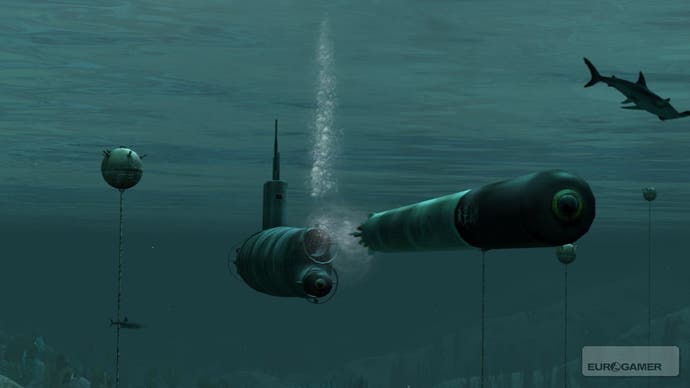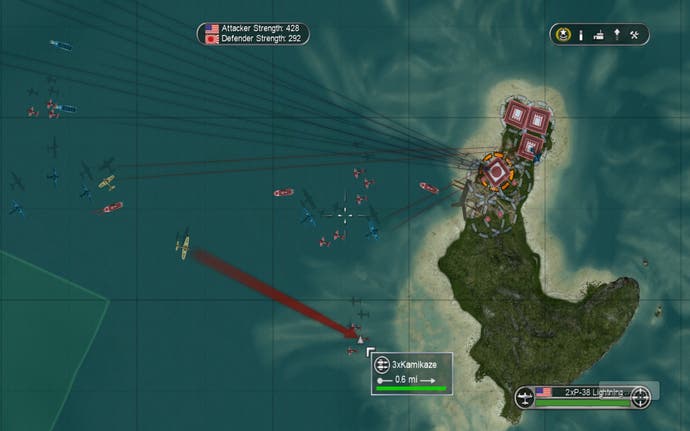Battlestations: Pacific
Plane sailing?
Battlestations: Midway has lived in the "flawed but promising" file ever since its release back in 2007. A peculiar hybrid of real-time strategy and shooting action, it tasked players with commanding various US naval forces through pivotal World War II scenarios.
You could direct your ships and planes from the tactical map, or prod a button and be instantly transported to the pilot's seat of a fighter or the artillery guns of a battleship. It was great in theory, but the reality was less enthralling due to a catalogue of clunky grumbles. The single-player campaign was truncated, the lack of checkpoints made long missions a real chore, the tutorial was tiresome and the multiplayer was too slim.
The good news is that all of these complaints have been addressed by the sequel, which picks up with the US Navy pushing towards Guadalcanal, their eyes fixed on the Japanese mainland. Not only is this scenario considerably more fleshed out than in the brief original, but it's joined by another parallel campaign in which you play as the Japanese, rewriting history as you emerge victorious from engagements that led to defeat in the real world. Opening, rather boldly, with the bombing of Pearl Harbor, to which you contribute, it's a welcome addition and one that pretty much doubles your single-player options.
Checkpoints have also been added to the missions, although the game is still tough enough that you can easily lose 20 or 30 minutes of progress should you fail, and, rather bizarrely, there's no option to restart from the last checkpoint within the game. You can jump back into a mission halfway through from the main menu, but restarting from the pause screen forces you to start over from the beginning. Discovering this the hard way, right near the end of a particularly lengthy encounter, was not funny.

Multiplayer has also benefited from a few blasts from the gameplay pump. Whereas before you got a series of maps, but only one game mode to play on them, there are now a decent spread of ways to play communally. Escort games find one side protecting a vessel while the others try to sink it. There are also competitive and co-operative modes, where you play on the same side, trying to either top your ally's score or work together for victory. All modes are playable as single-player skirmishes as well, so you can get some practice in, or just enjoy a standalone confrontation outside of the main campaign path.
More impressive, however, is Island Capture. This new mode takes advantage of one of the game's new features - the ability to send landing craft to capture ground installations - and the result is fantastic. Played on large, generous maps, these matches can be epic, with up to eight players battling to take and hold key locations, each of which bestows a gameplay perk. Take over a radar outpost, for example, and you get the option to recon the entire map. It's in this mode that the game's future potential seems to lie, offering a compelling naval complement to the sort of air and ground action found in DICE's Battlefield series.

The plodding tutorial has also gone, though this isn't exactly a good thing. It may have been overlong and off-putting, but at least it left you more than ready to tackle the unique challenges of directing battles at sea. Now we get nothing more than a practice mode, in which you can fart around and shoot down dummy enemies, but while this lets you fumble your way to an understanding of how the controls work, it does nothing to instruct you in the tactical nature of the game. Fine for a shooter, in other words, but a bit useless where strategy is concerned.
This rather obtuse nature was another of the original game's sticking points, so it's a shame that all the progress made in enhancing the options available hasn't resulted in a more obvious gameplay overhaul. In pure play terms this is, more or less, the exact same game as last time and the learning curve goes through the same awkward trajectory. First there's annoyance and confusion at the lack of guidance and the multitude of things you need to keep tabs on. This melts into grudging admiration once you get a handle on things and realise that there are some seriously cool ideas at work here, even if the execution sometimes seems to be going out of its way to stop you noticing them.








